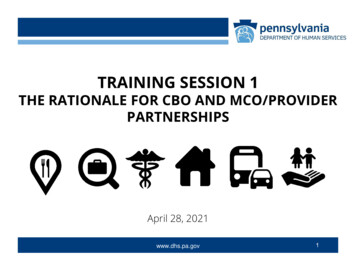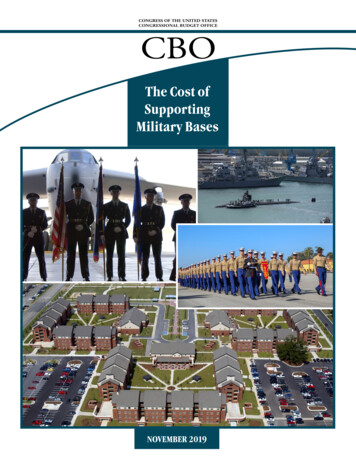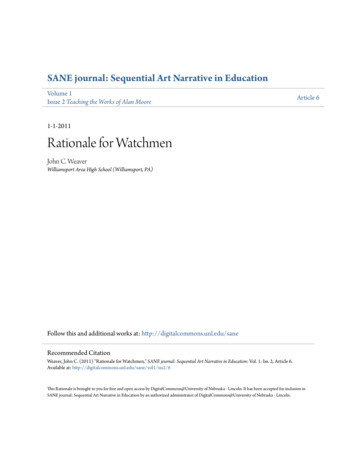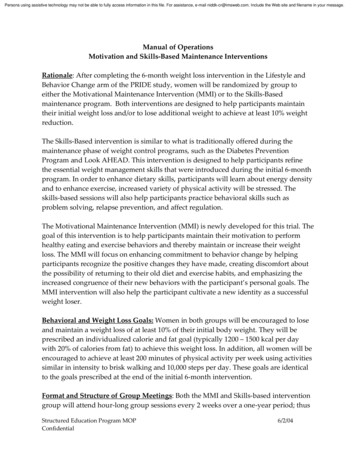
Transcription
TRAINING SESSION 1THE RATIONALE FOR CBO AND MCO/PROVIDERPARTNERSHIPSnApril 28, 2021www.dhs.pa.govwww.dpw.state.pa.us1
Agenda Welcome and Introduction Training Objectives Training Session Curriculum Context for Value-basedPurchasing (VBP) Rationale for VBP inPennsylvania Example CBO andMCO/Provider Partnerships Business Case Tool Post-Training Evaluation Q&AImage Source. Naturewww.dhs.pa.govwww.dpw.state.pa.us2
Virtual Training EtiquetteDue to the large number of attendees: Please turn off your video camera We will mute all lines during thepresentation Please use the chat feature to askquestions Be sure to ask for clarification whenneededImage Source. Ellicomwww.dhs.pa.govwww.dpw.state.pa.us3
The Social Determinants of HealthSocial Determinants of Health (SDoH):The social, environmental, and economic conditions that impact andaffect mental health & physical health outcomes across variouspopulations.Image Source. Ellicomwww.dhs.pa.govwww.dpw.state.pa.us4
DHS SDoH StrategyAssess for unmet social needs via the newlyprocured Resource and Referral Tool, RISE PA Multi-sector collaborative approach to addressing social determinants ofhealth and care coordinationBuild out partnerships with community-basedorganizations to address identified, unmet socialneeds Partnerships with community-based organizations for value-basedpurchasingMore generally, we should all work together toaddress community-level factors Regional Accountable Health Councils (RAHCs)www.dhs.pa.govwww.dpw.state.pa.us5
DHS SDOH StrategyBUILDING PARTNERSHIPSRecognize that some CBOsmay need resources andtraining to support theirefforts to form productivepartnerships with MCOsand provider organizationswww.dhs.pa.govwww.dpw.state.pa.us6
Training ScheduleTrainingTraining Session 1:The Rationale for CBOand MCO/ProviderPartnershipsTimelineApril 289:00 a.m.FocusAn overview of Value-based Purchasing (VBP), customizedfor a CBO audience, focusing on the rationale and goals oftransitioning from fee-for-service to MCO/provider contractsthat are part of a VBP arrangement.Training Session 2:Aligning CBOGovernance andOperations with MCOand/or ProviderPartnershipsTraining Session 3:Evaluating CBOOpportunities andNegotiating anAgreementMay 1711:00 a.m.An overview of how CBOs can best align and adapt theirgovernance and operations to support participation in anMCO and/or provider contract.May 2811:00 a.m.This session will focus on evaluation of readiness forpartnerships, as well as considerations for picking an MCOor provider organization partner and negotiating anagreement.Training Session 4:CBO Workshop SessionJune 174:00 p.m.This workshop-style session will seek to provide examplesfor how CBOs can plan for and implement SDoHinterventions that are part of a value-based purchasingarrangement between MCOs and provider organizations.7www.dhs.pa.govwww.dpw.state.pa.us7
Training ResourcesBUILDING PARTNERSHIPSAll four training sessionsare being recorded. Theserecordings, the slides, andtools will be posted on theDepartment of HumanServices website.www.dhs.pa.govwww.dpw.state.pa.us8
Training Session Facilitators Center for Evidence-based Policy Susan Stuard, MBA, Lead for Pennsylvania TA Mike Bonetto, PhD, Member of Pennsylvania TA Brittany Lazur, MPH, Policy Analyst Allyson Evans, JD, MED Director Nicole Thompson, Project Coordinator Daniel Vizzini, Policy Analystwww.dhs.pa.govwww.dpw.state.pa.us9
Training Objectives High-level overview of valuebased purchasing and howCBOs can be involved Overview of benefits andchallenges of CBOpartnerships with MCOsand/or provider organizationsImage Source. New York State Department of Healthwww.dhs.pa.govwww.dpw.state.pa.us10
Commonly Used Acronyms CBO: community-based organization DHS: Department of Human Services MCO: managed care organization RAHCs: Regional Accountable Health Councils SDoH: social determinants of health VBP: value-based purchasingwww.dhs.pa.govwww.dpw.state.pa.us11
Managed Care OrganizationsManaged care organizationscoordinate delivery of care andpayment of services for Medicaidenrollees.They enter into contracts withhealth care providers and medicalfacilities to provide care fortheir members.Image Source. Managed Care Networkwww.dhs.pa.govwww.dpw.state.pa.us12
Context for Value-based Purchasingwww.dhs.pa.govwww.dpw.state.pa.us13
What is Value?(Client)Image Source. PM360www.dhs.pa.govwww.dpw.state.pa.us14
What is Value-based Purchasing?Payment toproviders andorganizationsQuality of careHealth outcomeswww.dhs.pa.govwww.dpw.state.pa.us15
What is Value-based Purchasing?For the purposes of this contract, the CBOs must provide (and preferably have ahistory of successfully providing) services within the following eEmploymentUtilitiesClothingFinancial strainMust be committed to adopting RISE PA when available in their countywww.dhs.pa.govwww.dpw.state.pa.us16
Guiding Principles for PAImprove qualityReduce costAddress identified, unmet socialdeterminant of health needsPromote health equityIntegrate physical and behavioralhealth across the lifespanwww.dhs.pa.govwww.dpw.state.pa.us17
VBP Arrangements: MCO/ProvidersShared w.state.pa.us18
CBO InvolvementDHS has indicated 3 ways in which CBOs can beinvolved: Direct contract with an MCO Direct contract with a provider who is in a valuebased purchasing agreement with an MCO Shared savings with an MCO and a providerwww.dhs.pa.govwww.dpw.state.pa.us19
CBO InvolvementDirect contract with an MCOMCOCBODirectcontractFee-for-service, capitated rate, or us20
CBO InvolvementDirect contract with a providerwho is in a value-based purchasing (VBP) arrangementwith an or-service, capitated rate, or us21
CBO InvolvementMCOShared savings with an MCOand a providerCBOProviderShared savingswww.dhs.pa.govwww.dpw.state.pa.us22
CBO InvolvementCBOs can, but are not required to,be paid through value-basedpurchasing arrangements. If CBOsengage in a value-basedpurchasing arrangement, it shouldnot involve downside risk.www.dhs.pa.govwww.dpw.state.pa.us23
Rationale for Value-based Purchasingin Pennsylvaniawww.dhs.pa.govwww.dpw.state.pa.us24
Rationale for Health Transformationwww.dhs.pa.govwww.dpw.state.pa.us25
PA Health Transformation WorkOn October 2, 2020, Governor Tom Wolf issued an executive order outliningthe state’s reform proposal, including the formation of:InteragencyHealth ReformCouncil (IHRC)Goals: holding payors andproviders accountablewith respect to cost andvalueGoals: findingefficiencies in thehealthcare systemRegionalAccountableHealth Councils(RAHCs)Health ValueCommissionwww.dhs.pa.govGoals: .pa.us26
Timeline for CBO InclusionJanuary 1, 2021New agreementstartsJune 1, 202150% of medium and high riskVBP payment strategies mustincorporate at least 1 CBO thataddresses 1 SDOH domainMarch 1, 202125% of medium and high riskVBP payment strategies mustincorporate at least 1 CBO thataddresses 1 SDOH domainJanuary 1, 2022Next agreementyear beginsSeptember 1, 202175% of medium and high risk VBP paymentstrategies must incorporate at least 1 CBOthat addresses 1 SDOH domain, and 25% ofVBP payment strategies must incorporate 1 ormore CBOs that address 2 or more mage Source. Shutterstock
Examples of state.pa.us28
Examples: Food SecurityTogether in Care (MD)Partners: Meals on Wheels of CentralMaryland and John’s Hopkins BayviewMedical CenterTarget population: food insecure, homebound seniorsServices provided: meal delivery, in-homesafety checks, fall prevention, medicationreminders, engagement to minimizeloneliness and depressionValue aspect: designed to ensure that anyfuture hospitalizations are clinicallynecessaryFunding: direct contractImage Source. Quantified Ventureswww.dhs.pa.govwww.dpw.state.pa.us29
Examples: Food SecurityGod’s Love We Deliver (NY)Partners: 30 Managed Long Term Care, DualEligible, and Programs of All-inclusive Care for theElderly (PACE)Target population: Medicaid beneficiaries withchronic illnesses and high healthcare costsServices provided: medically-tailored meals andnutrition therapy, flexible plans and deliveryValue aspect: aims to reduce high healthcare costsand utilization among the top 5% of beneficiarieswho account for 50% of health care spendingFunding: direct contract, value-based purchasingImage Source. God’s Love We Deliverwww.dhs.pa.govwww.dpw.state.pa.us30
Examples: Housing SecurityEmpire Housing Pilot (NY)Partners: The Bronx Health & HousingConsortium and Empire BlueCross BlueShieldTarget population: houseless MedicaidbeneficiariesServices provided: initial identification,selection refinement, location/engagement,supportive housingValue aspect: aimed to decreasehospitalizations and emergency departmentvisits, and tracked pre/post Medicaidutilization/spendFunding: direct contractImage Source. New York State Department of Healthwww.dhs.pa.govwww.dpw.state.pa.us31
Examples in PennsylvaniaPartners: Health Partners Plans,Philabundance, and Food ConnectTarget population: food insecureindividuals and familiesServices provided: home fooddeliveryValue aspect: pairing food deliverywith social determinants of healthinterventions (e.g., vocational training)and health servicesFunding: direct contract and SNAP 5050 fundingwww.dhs.pa.govImage Sources. Health Partners Plans, Philabundance, Food Connectwww.dpw.state.pa.us32
Examples in PennsylvaniaPartners: AmeriHealth CaritasPennsylvania/Keystone First andMannaTarget population: food insecureindividuals and familiesServices provided: food servicesValue aspect: Keystone casemanagers refer cases to Manna,who in turn provide services basedon member’s needsFunding: direct contractwww.dhs.pa.govImage Sources. AmeriHealth Caritas, Keystone First, Mannawww.dpw.state.pa.us33
Examples in PennsylvaniaPartners: UPMC Health Plan and CommunityHuman ServicesTarget population: unhoused individualsand familiesServices provided: supportive housing andcare coordinationValue aspect: uses predictive analytics toidentify Medicaid recipients who are on a pathto significant use of low-value health care andwho are likely to benefit from stable housingand enhanced care coordinationFunding: transitioned from program funding,to per-member per-month quality bonuses, tovalue-based purchasingImage Sources. UPMC Health Plans and Community Human Serviceswww.dhs.pa.govwww.dpw.state.pa.us34
Examples in PennsylvaniaHousing Smart InitiativePartnerships: Resources for HumanDevelopment, Temple University HealthSystem, Health Partners Plans, KeystoneFirstTarget population: high health serviceutilizersServices provided: supportive housingand care coordinationValue aspect: aims to reduceemergency department visits for highhealth service utilizersFunding: direct funding to CBO; valuebased purchasing contract for CBO wasdiscussed but not yet executedImage Sources. Resources for Human Development and Temple University Health Systemwww.dhs.pa.govwww.dpw.state.pa.us35
Lessons LearnedSuccessesChallenges Quality assurance Data use agreements may besufficient in some cases Additional funding provided byMCOs to CBOs to support theirwork Addressing targeted socialdeterminants of health areas Ability to scale over time Transition to value-basedpurchasing over time Reporting requirements Identifying and trackingbeneficiaries Data collection and sharing Payment for indirect costs Contracting and businessassociate agreements HIPAA, patient consent, and recordkeeping Paradigm shift (communities vs.members)www.dhs.pa.govwww.dpw.state.pa.us36
Business Case Toolwww.dhs.pa.govwww.dpw.state.pa.us37
Business Case Tool: Overviewwww.dhs.pa.govwww.dpw.state.pa.us38
Business Case Tool1. Describe the SDoH intervention, highlighting elements that couldbe used to incorporate quality assurance. What is the anticipatedROI and/or evidence for the SDoH intervention?2. How will the CBO staff the SDoH intervention? Will new staff oradditional training be required?3. What data will be exchanged with the applicable MCO and/orprovider organization and at what intervals? What steps must betaken to obtain consent to share information across systems?4. What technology will be used to track and transmit these data?5. In what geographic area will the intervention be implemented?www.dhs.pa.govwww.dpw.state.pa.us39
Business Case Tool6. What is the target population for the intervention? What is theestimated volume of individuals who would receive theintervention and how will their eligibility be identified? How willindividuals be selected? What agreements are needed to refermembers?7. How will the intervention be tracked and evaluated? Whatmeasures will be used?8. What is the timeline for implementation?9. How will the CBO be paid for its SDoH intervention?10.What are the key risks of the proposed CBO-MCO-Providerpartnership to implement this intervention? How might these risksbe mitigated?www.dhs.pa.govwww.dpw.state.pa.us40
Post-Training Evaluationwww.dhs.pa.govwww.dpw.state.pa.us41
Poll Everywhere Navigate to the linkPollEv.com/cebpohsu300and waitElectronicVoting Instructionsfor the question prompts on yourscreen You should be able to click on linkinserted into the chat feature If you wish to be anonymous, selectthe skip option when prompted toenter your name Your device will automatically advanceyou to the active poll Results will appear on the screenupon entry submission; you areallowed to change your responses ifyou wish42www.dhs.pa.govwww.dpw.state.pa.us42
www.dhs.pa.govwww.dpw.state.pa.us43
www.dhs.pa.govwww.dpw.state.pa.us44
www.dhs.pa.govwww.dpw.state.pa.us45
www.dhs.pa.govwww.dpw.state.pa.us46
Q&AThank you for your participation!www.dhs.pa.govwww.dpw.state.pa.us47
Target population: food insecure individuals and families Services provided: home food delivery Value aspect: pairing food delivery with social determinants of health interventions (e.g., vocational training) and health services Funding: direct contract and SNAP 50-50 funding Image Sources. Health Partners Plans, Philabundance, Food Connect










